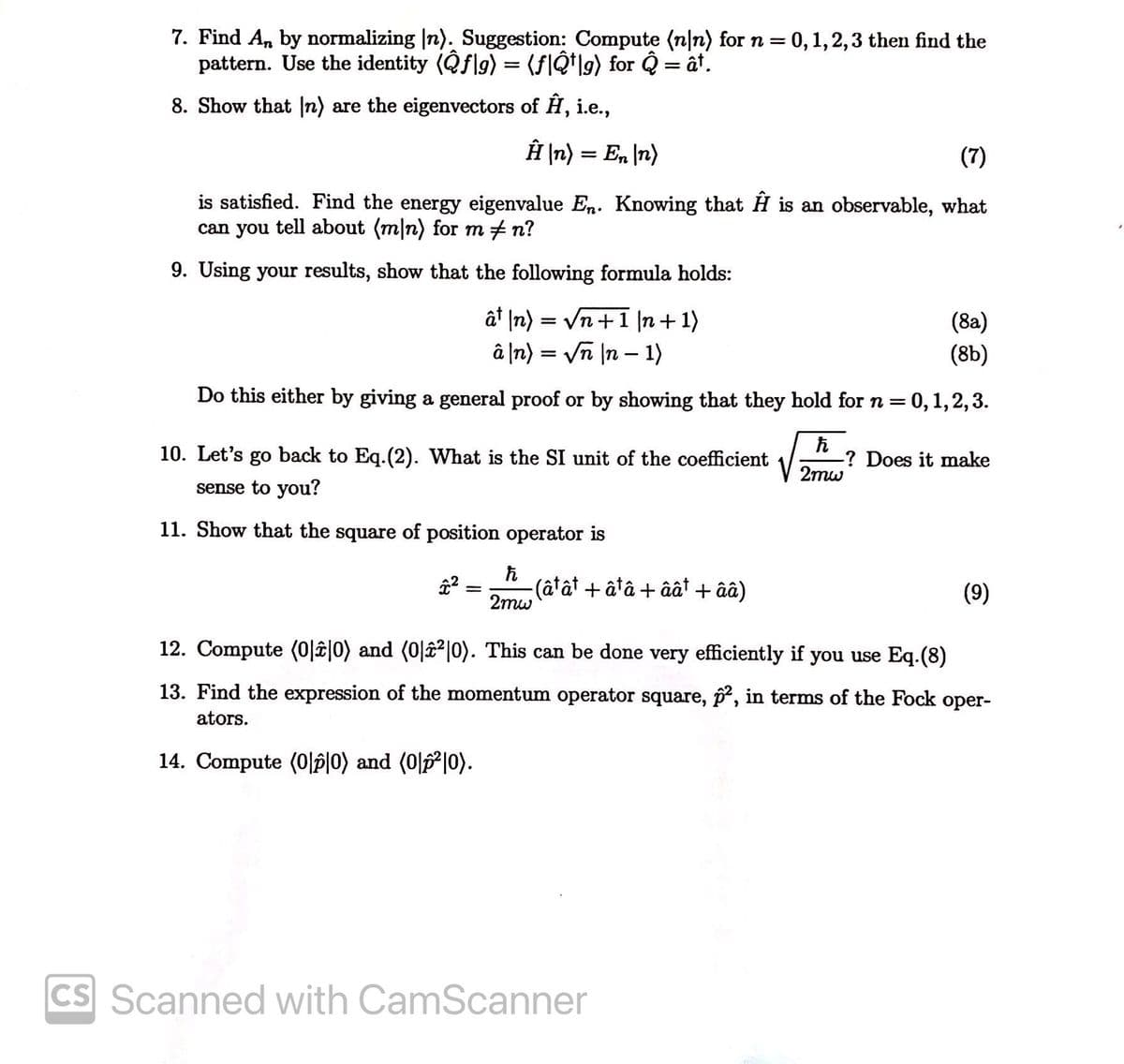14. Compute (0|p|0) and (0\f*|0).
Related questions
Question
PLEASE ANSWER #14. The first page is provided for context.

Transcribed Image Text:7. Find An by normalizing |n). Suggestion: Compute (n|n) for n=0,1,2,3 then find the
pattern. Use the identity (Qflg) = (fIQ*lg) for Q = ât.
8. Show that n) are the eigenvectors of H, i.e.,
ÊĤ \n) = En \n)
(7)
is satisfied. Find the energy eigenvalue En. Knowing that H is an observable, what
can you tell about (m|n) for m + n?
9. Using your results, show that the following formula holds:
ât \n) = Vn+1 |n+ 1)
â \n) = Vn |n – 1)
(8a)
(8b)
Do this either by giving a general proof or by showing that they hold forn=
= 0,1, 2, 3.
10. Let's go back to Eq.(2). What is the SI unit of the coefficient
-? Does it make
2mw
sense to you?
11. Show that the square of position operator is
(âtât + âtâ + âât + ââ)
2mw
(9)
12. Compute (0|î|0) and (0|â²|0). This can be done very efficiently if you use Eq.(8)
13. Find the expression of the momentum operator square, p, in terms of the Fock oper-
ators.
14. Compute (0|p|0) and (0|p²|0).
CS Scanned with CamScanner
![The Fock operator â is defined by
(±+ mu)
å -
â =
(1)
2h
where î and p are the position and momentum operators, respectively.
1. Write down ât in terms of £ and p.
2. Show that
(ât + â)
2mw
(2)
||
himw
p = i
(ât – â)
2
(3)
%3D
hold.
3. Show that the cannonical communation relation, [ê, f] = iħ, yields the so-called bosonic
commutation relation,
(â, ât] = 1.
(4)
4. Show that the Hamiltonian of the SHO, H =
2m
is written as
ÎĤ = f (N +)
(5)
where N = âtâ is called the number operator.
5. Show that Ñ is Hermitian. Suggestion: Use the identity from Exercise #1, (QR)t =
6. A normalized vector |0) (so that (0|0) = 1) is defined to satisfy â|0) = 0. With this
the following vectors are constructed:
|n) = An (ât)" |0) for n =
0,1,2,...
(6)
where A, are constant with Ao = 1. Compute N|n) for n =
are the eigenvectors of N, i.e., Ñ|N) is proportional to |N). Find the eigenvalues of
N from the proportionality.
0,1,2,3 to show that these
CS Scanned with CamScanner](/v2/_next/image?url=https%3A%2F%2Fcontent.bartleby.com%2Fqna-images%2Fquestion%2F4b2dbe0f-1b57-45b1-b136-e64e5f1cae33%2Fb8549a86-30e8-4260-933d-ee8fa1aeaadb%2F04ijpeq_processed.jpeg&w=3840&q=75)
Transcribed Image Text:The Fock operator â is defined by
(±+ mu)
å -
â =
(1)
2h
where î and p are the position and momentum operators, respectively.
1. Write down ât in terms of £ and p.
2. Show that
(ât + â)
2mw
(2)
||
himw
p = i
(ât – â)
2
(3)
%3D
hold.
3. Show that the cannonical communation relation, [ê, f] = iħ, yields the so-called bosonic
commutation relation,
(â, ât] = 1.
(4)
4. Show that the Hamiltonian of the SHO, H =
2m
is written as
ÎĤ = f (N +)
(5)
where N = âtâ is called the number operator.
5. Show that Ñ is Hermitian. Suggestion: Use the identity from Exercise #1, (QR)t =
6. A normalized vector |0) (so that (0|0) = 1) is defined to satisfy â|0) = 0. With this
the following vectors are constructed:
|n) = An (ât)" |0) for n =
0,1,2,...
(6)
where A, are constant with Ao = 1. Compute N|n) for n =
are the eigenvectors of N, i.e., Ñ|N) is proportional to |N). Find the eigenvalues of
N from the proportionality.
0,1,2,3 to show that these
CS Scanned with CamScanner
Expert Solution
This question has been solved!
Explore an expertly crafted, step-by-step solution for a thorough understanding of key concepts.
This is a popular solution!
Trending now
This is a popular solution!
Step by step
Solved in 3 steps with 3 images
